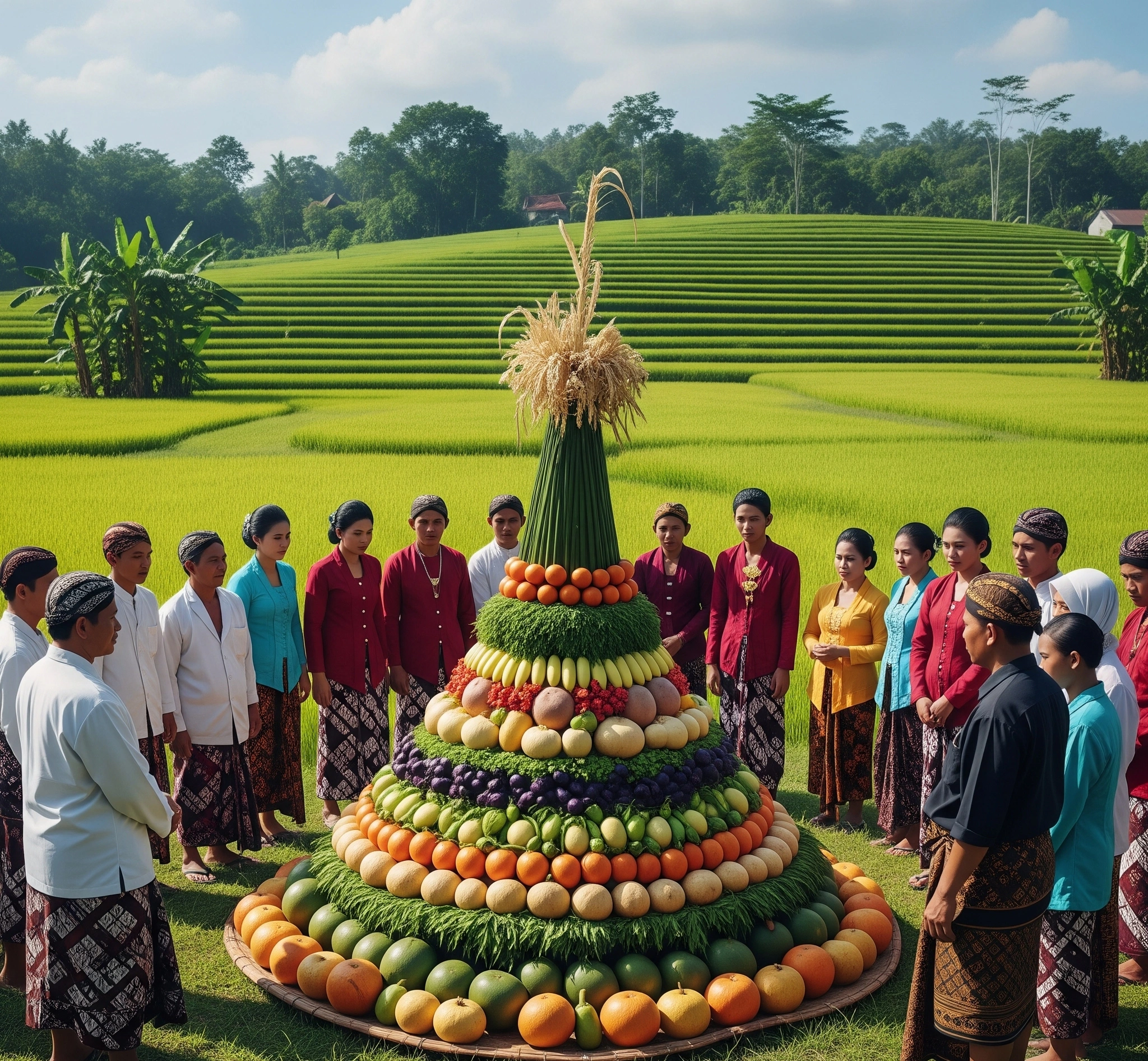In our fast-paced world, many feel a growing disconnect from the very ground that sustains us. We often overlook the profound relationship between humanity and nature, leading to unsustainable practices and a sense of imbalance. How can we rekindle this vital connection and foster a spirit of gratitude for the earth’s bounty? This article delves into Sedekah Bumi, a powerful Javanese tradition that offers a profound answer. We will explore this ancient ritual not as mere superstition, but as a practical wisdom for ecological harmony, community solidarity, and personal well-being. Discover how this earth gratitude ritual can enrich your life and the world around you.
Table of Contents
- What is Sedekah Bumi? Unveiling Javanese Earth Gratitude
- The Dimensions of Gratitude: Exploring the Forms of Sedekah Bumi
- The Modern Community’s Harvest: Sedekah Bumi in Action
- Actionable Solutions: Practicing Earth Gratitude in Modern Life
- The Timeless Relevance of Sedekah Bumi in the Digital Age
- Returning to the Earth’s Embrace
What is Sedekah Bumi? Unveiling Javanese Earth Gratitude
Sedekah Bumi, literally meaning “alms of the earth” or “giving to the earth,” is a traditional Javanese ritual of gratitude. Communities perform it annually, typically after the harvest season. This ceremony expresses profound thanks to God Almighty and to the earth (often personified as Dewi Sri, the rice goddess) for a bountiful harvest and continued fertility. It is a communal act of reverence, acknowledging humanity’s dependence on nature’s generosity.
The origins of Sedekah Bumi are deeply embedded in ancient Javanese agrarian societies. These traditions predate the major religions, reflecting animistic beliefs in the spiritual essence of nature. Over centuries, these indigenous practices integrated with Hindu-Buddhist philosophies and later, with Islamic teachings, particularly Sufi mysticism. This fusion created a unique syncretic tradition. Key figures in Javanese history and local community leaders have consistently upheld Sedekah Bumi. This underscores its cultural and spiritual significance. The core principle is reciprocity: by giving back to the earth, the community ensures its continued well-being and prosperity. Therefore, this is practical wisdom, not mere superstition; it is a symbolic interpretation of human experience, not magic.
The Dimensions of Gratitude: Exploring the Forms of Sedekah Bumi
Sedekah Bumi manifests through various symbolic acts and communal gatherings. Each component serves to deepen the community’s connection to the earth and to each other. Understanding these patterns reveals the ritual’s rich cultural and spiritual layers.
The Symbolism of Offerings (Sesaji)
Meaning/Interpretation: Offerings, known as ‘sesaji,’ are central to Sedekah Bumi. These typically include agricultural products like rice, various vegetables, fruits, traditional snacks, and sometimes livestock. They are arranged beautifully on a ‘gunungan’ (a conical mound), symbolizing mountains and abundance.
Explanation: The ‘sesaji’ represents the community’s best produce, offered back to the source of life. This act signifies gratitude and humility. It also acknowledges the cyclical nature of life and the earth’s continuous provision. Philosophically, the offering is an act of surrendering ego and recognizing a higher power (God/nature) as the ultimate provider. It is an offering of gratitude, not a feeding of spirits, emphasizing a spiritual exchange.
Dualities/Paradoxes: While it involves giving away valuable resources, this act paradoxically ensures future abundance. It highlights the principle that generosity and respect for nature lead to sustained prosperity, demonstrating a profound spiritual economy.
Community Feast and Shared Blessings
Meaning/Interpretation: After the formal ritual, the offerings are often shared in a communal feast, known as ‘kenduri’ or ‘slametan.’ This gathering fosters social cohesion and reinforces community bonds.
Explanation: The shared meal symbolizes unity and equality within the community. It is a moment for collective celebration, where blessings from the earth are distributed among all members. This reinforces the idea that the earth’s bounty is for everyone and that communal harmony is essential for collective well-being. It strengthens social ties and mutual support.
Dualities/Paradoxes: The act of sharing, which might seem to diminish individual portions, actually amplifies collective joy and solidarity. This shows that true richness lies in communal prosperity and shared happiness, rather than individual accumulation.
The Ritual of Procession (Kirab)
Meaning/Interpretation: In many Sedekah Bumi ceremonies, a ‘kirab’ or procession takes place. Villagers carry the ‘gunungan’ and other offerings around the village or to a sacred site. This public display celebrates the harvest and connects the community with its land.
Explanation: The procession is a vibrant expression of communal identity and pride. It allows everyone to participate actively in the ritual, reinforcing a collective sense of ownership and responsibility towards the land. The journey itself can be seen as a symbolic pilgrimage, deepening the participants’ spiritual connection to their environment and heritage.
Dualities/Paradoxes: The physical effort of the procession, though tiring, brings immense spiritual satisfaction and strengthens the community’s collective spirit. It demonstrates that active participation and shared effort lead to deeper appreciation and stronger bonds.
The Modern Community’s Harvest: Sedekah Bumi in Action
Consider the village of Sumber Makmur, a small farming community facing modern challenges. Younger generations were increasingly drawn to city life, and traditional farming practices seemed less appealing. There was a growing disconnect between the youth and their agricultural heritage. Additionally, climate change brought unpredictable weather patterns, making harvests more precarious. The community felt a subtle erosion of its collective spirit and a weakening of its bond with the land.
The village elders decided to revitalize their annual Sedekah Bumi ceremony. They invited everyone, especially the youth, to participate actively. The preparation became a month-long event, involving communal farming, crafting traditional offerings, and sharing ancestral stories about the land. The youth, initially skeptical, found themselves drawn into the collective effort. They learned about sustainable farming from their grandparents and rediscovered the joy of working the soil.
Reconnecting Generations and Land
On the day of the ceremony, the entire village gathered. The ‘gunungan’ of fresh produce was magnificent. The ‘kirab’ procession was vibrant, with children carrying small baskets of flowers and elders leading traditional chants. Anya, a young woman who had almost moved to the city, felt an “Aha!” moment during the communal feast. As she shared food prepared from the village’s harvest, she realized the profound interconnectedness of her community, her family, and the land. The ritual wasn’t just about giving thanks; it was about reaffirming their identity, their resilience, and their shared future.
This modern Sedekah Bumi didn’t magically solve climate change. However, it reignited a sense of purpose and unity in Sumber Makmur. The renewed appreciation for their land led to more sustainable farming initiatives. Furthermore, a stronger community bond encouraged more youth to stay and contribute. The ancient wisdom of Sedekah Bumi provided a powerful framework for addressing contemporary issues of environmental sustainability and social cohesion.
Actionable Solutions: Practicing Earth Gratitude in Modern Life
Understanding the philosophy of Sedekah Bumi is a powerful first step. However, real transformation requires concrete action and consistent practice. These are empowering self-practices, not mystical rituals to control external forces, but tools for profound personal and communal growth.
-
Mindful Consumption and Local Support:
How to apply it: Practice mindful eating by consciously appreciating where your food comes from. Support local farmers and producers by buying fresh, seasonal produce from farmers’ markets or community-supported agriculture (CSA) programs. Consider growing a small herb garden or a few vegetables yourself, even on a balcony.
Purpose: This practice directly connects you to the earth’s bounty and the labor involved in food production. It fosters gratitude for sustenance and promotes sustainable food systems, embodying the spirit of giving back to the local ecosystem.
-
Community Gardening or Green Initiatives:
How to apply it: Get involved in a local community garden. If one doesn’t exist, consider starting a small green initiative in your neighborhood, like planting trees or cleaning up a local park. Dedicate time and effort to nurturing a shared green space.
Purpose: This embodies the communal aspect of Sedekah Bumi. It fosters solidarity and collective responsibility towards the environment. Working together on green projects strengthens community bonds and creates tangible benefits for the local ecosystem.
-
Daily Gratitude for Nature:
How to apply it: Integrate a simple daily practice of acknowledging nature’s gifts. This could be a moment of silent thanks before a meal, a conscious appreciation of a tree or a flower on your walk, or a short reflection on the clean air and water you consume. You can also make a small, symbolic offering (like returning a fallen leaf to the soil) as an act of reverence.
Purpose: This cultivates a consistent mindset of gratitude and reverence for the earth. It helps you recognize the constant flow of abundance from nature, deepening your personal connection to the environment and fostering a sense of interconnectedness.
 The Timeless Relevance of Sedekah Bumi in the Digital Age
The Timeless Relevance of Sedekah Bumi in the Digital Age
In an era grappling with climate change, environmental degradation, and social fragmentation, the principles of Sedekah Bumi offer profound wisdom. Its emphasis on gratitude, reciprocity, and community harmony provides a powerful framework for addressing contemporary challenges. The ritual’s focus on sustainable living and collective responsibility is more relevant than ever.
By integrating the spirit of Sedekah Bumi into modern life, we can foster a deeper ecological consciousness. We encourage sustainable consumption patterns. We also strengthen community resilience. The benefits are tangible: healthier ecosystems, stronger social bonds, reduced waste, and a greater sense of purpose and belonging. This ancient tradition empowers us to live more harmoniously with nature and each other, creating a more sustainable and equitable future.
Returning to the Earth’s Embrace
Sedekah Bumi is far more than an annual ceremony; it is a timeless philosophy of life. It offers a powerful reminder of our intrinsic connection to the earth and to our communities. By embracing its principles, we move beyond mere consumption to active participation in a cycle of giving and receiving. This ancient Javanese tradition demystifies our relationship with nature, revealing it as a partnership built on gratitude, respect, and shared responsibility.
“The earth does not belong to us; we belong to the earth. In giving back, we find our true home.”
Call to Action
Ready to deepen your connection with the Earth and your community?
Context and References
Internal Links to Related Articles:
- Read more about the universal principles of [Javanese cultural traditions and rituals here].
- Discover how [ancient wisdom traditions promote ecological harmony here].
- Explore the power of [community building and local sustainability initiatives here].
External References (If Applicable):
- Wikipedia: Sedekah Bumi
- [Academic papers on Indonesian agrarian rituals and community traditions (e.g., from JSTOR or university presses)]
- [Reputable cultural studies resources on Javanese spiritual practices]
Disclaimer:
This content is provided for educational and cultural understanding. Philosophical and traditional concepts are part of a rich heritage, offering guidance for fostering gratitude, community, and ecological responsibility, not deterministic prophecies or absolute judgments.
About the Author/Source:
This wisdom is shared by The Nusantara Sage — a symbolic figure representing timeless wisdom, simplicity, and compassion. These writings are meticulously crafted by the [Your Website Name] team, comprised of cultural researchers, academics, and spiritual practitioners dedicated to preserving and translating ancient wisdom into a relevant format for contemporary generations. We believe that ancestral heritage is not merely a relic, but a compass for life. Each article is written through a process of research, cross-generational discussion, and deep contemplation, to ensure accuracy and the profound nobility of its contained values. Learn more about our authors and philosophy.
